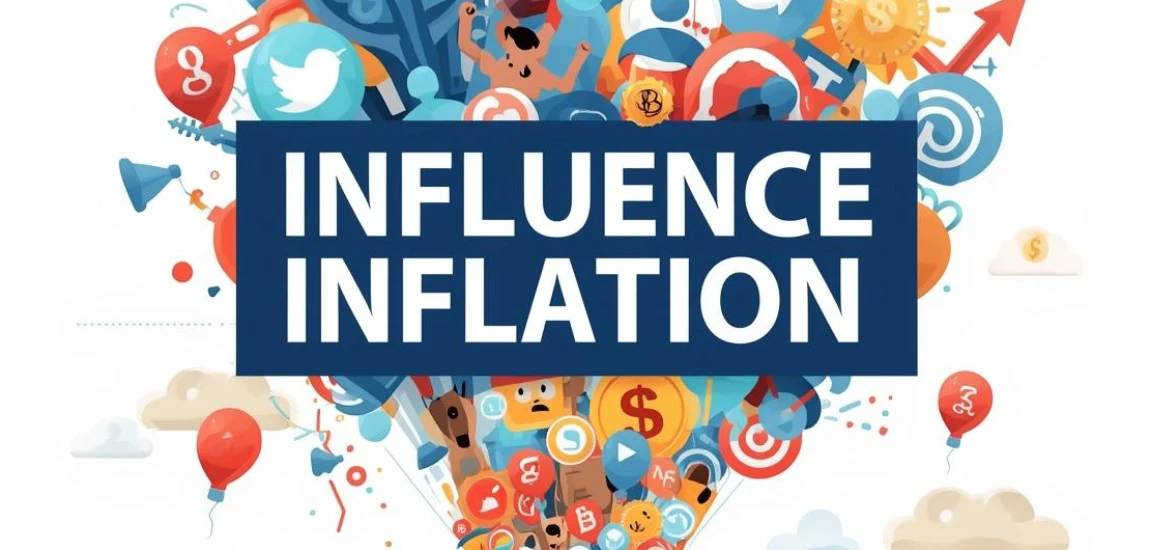Influence Inflation: When Everyone’s a Brand, Who’s Left to Buy?

Once upon a time, influence meant expertise, authority, or a distinct voice that shaped opinions. Today, it’s a universal ambition. The internet has democratized fame, turning everyday users into content creators and content creators into personal brands. But as influence becomes more common, its value begins to erode. The influencer economy—built on attention, authenticity, and aspiration—is now confronting a crisis of oversaturation.
This post dives deep into what happens when everyone is trying to sell something, explore how “influence inflation” changes our culture of consumption, and consider what might come next in a world where authenticity itself feels manufactured.
The Age of Ubiquitous Influence: How Everyone Became a Brand

The Personal Brand Revolution
It started innocently enough. Social media gave individuals a voice, and branding that voice became a means of standing out in an increasingly crowded digital landscape. Platforms like Instagram, TikTok, and LinkedIn encouraged users to “build their personal brand,” transforming self-expression into self-marketing. Today, everyone—from freelancers to students—curates their lives as if they’re managing a micro-company.
The Creator Economy Explosion
The rise of the creator economy promised freedom from traditional employment. Millions of people turned to digital creation for income, recognition, and self-definition. But as the number of influencers ballooned, the audience didn’t grow at the same rate. The market became flooded, and attention—the most precious currency of the digital age—became harder to earn.
Influence as Identity
Influence is no longer a side effect of success; it is the goal. People are building brands before building skills, curating aesthetics before purpose. This shift means identity is often shaped by what is marketable rather than what is meaningful. When everyone performs influence, the distinction between creator, consumer, and audience begins to vanish.
The Economics of Attention: When Supply Exceeds Demand

The Saturation Point of Influence
In economic terms, influence inflation occurs when there’s an oversupply of influencers relative to audience attention. There are more people selling influence than consuming it. Every niche, trend, and aesthetic has hundreds of accounts replicating the same formulas—pastel feeds, inspirational captions, wellness routines. As a result, influence has become less about originality and more about optimization.
The Shrinking Value of Authenticity
Authenticity was once the golden rule of influence—“be real, be relatable.” But now, authenticity itself is an aesthetic. Sponsored “vulnerability” and strategic imperfection have made audiences skeptical. The emotional connection that once powered influencer culture is being replaced by fatigue and distrust. People no longer believe every “honest review” or “life update”—they see the sales pitch underneath.
Algorithmic Inflation
Algorithms, too, play a role in this devaluation. Platforms amplify what’s already trending, rewarding sameness over substance. As more users chase algorithmic approval, the diversity of voices diminishes. What remains are endless variations of the same “successful” content archetypes. The result? Diminished attention spans, brand fatigue, and audiences disengaging from influencer culture altogether.
The Consumer-Influencer Paradox: When Audiences Become Sellers

Blurring Roles in the Attention Economy
In the early days of influencer marketing, the roles were clear: influencers sold, audiences bought. But now, audiences are becoming influencers themselves. Every consumer is encouraged to “share,” “review,” or “collaborate.” Ordinary users now curate mini-brands through product links, affiliate codes, and lifestyle posts. The hierarchy collapses—everyone is both selling and being sold to.
Micro-Influence and Monetized Friendship
The rise of micro- and nano-influencers has turned social relationships into transactional ones. A friend’s recommendation might be genuine—or it might be a paid post. The intimacy that once defined online communities is increasingly monetized. Trust becomes the new currency, and it’s easily overdrawn. This creates a paradox: we crave connection but distrust anyone trying to profit from it.
The Decline of the Passive Consumer
The idea of a “pure” consumer—someone who only observes, not promotes—is disappearing. Every user now contributes to the economy of influence, whether through engagement, reposts, or co-creation. While this democratizes expression, it also dilutes the impact of influence itself. If everyone is shouting, no one’s voice carries very far.
Emotional Labor and Performance Fatigue in the Influencer Economy

The Pressure to Stay Relevant
Being an influencer isn’t just about creating—it’s about maintaining visibility. Algorithms reward consistency, pushing creators to post constantly. The result is emotional burnout: creators must perform authenticity on demand, crafting personas that align with their audience’s expectations. The pressure to stay “on-brand” can make self-expression feel more like surveillance than freedom.
The Cost of Constant Curation
Behind every polished feed lies a relentless cycle of editing, scripting, and optimizing. Even “casual” content is often meticulously planned. This constant performance creates cognitive dissonance—between how influencers appear and how they feel. Many report feeling disconnected from their real selves, trapped in the image they’ve built.
The Erosion of Privacy and Selfhood
As the boundary between personal and professional blurs, influencers—and now everyday users—struggle to separate identity from image. Every moment can become content; every emotion can be leveraged for engagement. Over time, this leads to identity fatigue: the exhaustion of living as both a person and a brand simultaneously.
The Future Buyer: From Passive Consumer to Participatory Creator

Community Over Clout
As influence becomes diluted, audiences are shifting their focus from big names to real communities. People crave genuine connection and shared values, not polished personas. The future of influence lies in micro-communities—spaces built around trust, conversation, and collaboration. Authentic engagement will outweigh follower counts in determining true impact.
The Rise of Collective Influence
Instead of a few individuals commanding mass attention, we’re moving toward distributed influence—where groups, fandoms, and communities collectively shape trends. Think Discord servers, Substack communities, or niche online clubs. Here, influence isn’t centralized—it’s participatory. Brands that understand this shift will thrive by supporting rather than dominating the conversation.
Reframing the Role of the Consumer
Consumers of the future will demand reciprocity. They won’t just buy—they’ll co-create, co-own, and co-promote. Web3 and decentralized platforms are already hinting at this new model, where audiences have a stake in the content they support. The next phase of digital culture won’t be about selling influence—it will be about sharing it.



